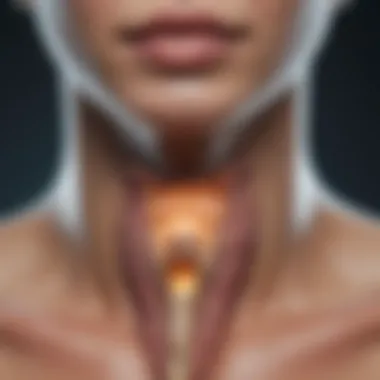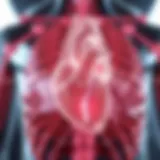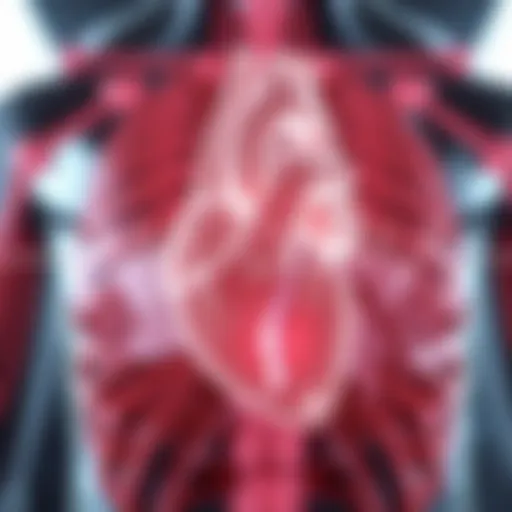Thyroid Nodule Scans: Insights for Patient Care


Intro
Navigating the terrain of thyroid nodule scans can feel a bit like walking through a maze. With numerous imaging techniques at your disposal and a variety of interpretations, it's easy to see why this topic requires thorough exploration. Thyroid nodules, which are lumps in the thyroid gland, can be benign or malignant, making their evaluation crucial for effective healthcare. This overview aims to dissect the significance of these scans, examining their role in diagnosing thyroid conditions as well as informing treatment options.
Key Concepts and Terminology
Definition of Key Terms
Understanding thyroid nodule scans starts with grasping some fundamental terms. Here are a few essential definitions that will set the stage for the subsequent discussions:
- Thyroid Nodule: A growth within the thyroid that may be solid or filled with fluid.
- Ultrasound: A non-invasive imaging technique using sound waves to create pictures of the thyroid.
- Fine Needle Aspiration (FNA): A procedure that uses a thin needle to extract cells from a nodule for further examination.
- Radioactive Iodine Scan: A technique that evaluates how well the thyroid is functioning, particularly in the presence of nodules.
Concepts Explored in the Article
Throughout the article, the following concepts will be explored in detail:
- The various types of imaging techniques used for thyroid nodules and their pros and cons.
- Protocols for interpreting scan results and the meaning of various findings.
- The clinical significance of these scans in diagnosing thyroid conditions.
- Implications of results and subsequent treatment pathways.
- Recommendations for follow-up care based on scan outcomes.
Findings and Discussion
Main Findings
Thyroid nodule scans can not only highlight the presence of nodules but can also shed light on their characteristics. For instance, a highly vascularized nodule might suggest certain types of thyroid disease that warrant close monitoring.
Scans can serve as a first-line diagnostic tool, but it is vital for healthcare providers to integrate results with patient history and clinical presentation.
The findings can dictate the further course of action: whether to monitor the nodule, conduct an FNA, or consider surgery.
Potential Areas for Future Research
There are still many unanswered questions in the realm of thyroid nodule imaging. Potential areas for future research include:
- Improved imaging techniques that increase resolution and diagnostic accuracy.
- Long-term studies on the natural progression of benign thyroid nodules.
- Greater understanding of how genetic factors may influence the behavior of thyroid nodules.
In summary, grasping the nuances of thyroid nodule scans is paramount for students, researchers, educators, and professionals alike. The importance of this topic spans beyond mere academic curiosity, as it directly influences patient care and outcomes.
Prologue to Thyroid Nodules
Thyroid nodules are becoming increasingly common in contemporary medical discussions. Understanding them requires diving into their nature, prevalence, and the associated health considerations. These lumps of tissue can provoke a range of emotions, from casual indifference to serious concern, depending on what they might signal concerning one’s health. Therefore, grasping the basic fundamentals surrounding thyroid nodules forms a crucial cornerstone for further exploration of diagnostic processes, including scans.
Definition of Thyroid Nodules
At the core, a thyroid nodule is a solid or fluid-filled cyst that emerges within the thyroid gland. This butterfly-shaped gland, nestled at the base of the neck, plays a pivotal role in regulating metabolism through hormone production. When talking about nodules, it is essential to clarify that they can be entirely benign or potentially malignant. Most nodules do not cause symptoms; hence many individuals might be unaware of their presence until routine imaging or examinations reveal them.
Recognizing the definition is not just about identifying the lumps; it sets the stage for understanding why some nodules can raise red flags during evaluations.
Epidemiology of Thyroid Nodules
The prevalence of thyroid nodules is notably higher than one might expect. Various epidemiological studies indicate that a significant proportion of the adult population may harbor these nodules. It's estimated that up to 50% of those over the age of 60 have thyroid nodules detectable by ultrasound. However, only a small fraction of them are cancerous. Factors such as age, sex, and geographical location can influence the occurrence of thyroid nodules. For instance, women are disproportionately affected compared to men, often for reasons that intertwine with hormonal variations. Such epidemiological insights underscore the necessity of vigilant screening practices, particularly in high-risk populations.
Significance of Evaluation
Evaluating thyroid nodules is no quick or easy task; it demands meticulous attention to detail. The implications of a nodule's nature cannot be overstated. Evaluations serve various purposes, including differentiating between benign and malignant nodules, determining the appropriate treatment course, and ultimately safeguarding patient health. Key factors such as size, growth rate, and patient’s risk profile all factor into the assessment process.
“An evaluation can turn a mere curiosity into a critical determinant of health; it’s pivotal to understanding one’s own body.”
Types of Thyroid Nodule Scans
Understanding the types of thyroid nodule scans lays a foundation for grasping how these imaging modalities aid in diagnosing and managing thyroid conditions. Each scan offers unique insights into the structure and functionality of the thyroid gland, making it a critical aspect in the evaluation of thyroid nodules. Knowing which scan to use can guide clinicians in tailoring their approach to each patient’s condition.
Ultrasound Imaging
Ultrasound imaging stands as one of the most widely employed techniques in the evaluation of thyroid nodules. It’s regarded for its non-invasive nature and lack of ionizing radiation, making it a safe choice for many patients. This method utilizes high-frequency sound waves to create images, helping identify the characteristics of nodules, including size, shape, and composition.
With ultrasound, practitioners can distinguish between solid and cystic nodules, which can significantly impact management decisions. For example, a simple cyst might only require routine follow-up, while a complex nodule could necessitate further investigation.


- Key Benefits of Ultrasound:
- Non-invasive with no radiation exposure
- Provides real-time imaging
- Allows for guided fine-needle aspiration if needed
However, ultrasound is not without its limitations. The operator's skill plays a key role in the quality of the images and subsequent interpretations. This brings us to the value of clinician experience in conjunction with technology.
CT Scans
CT scans offer a more detailed view of the neck region, utilizing X-rays to produce cross-sectional images. This method can be particularly useful in complex cases where the anatomy is not clearly visualized by ultrasound. They can reveal not only thyroid nodules but also adjacent structures, helping to assess any possible compressive effects from enlarged nodules.
The enhanced imaging ability can be vital in pre-operative planning, ensuring that surgeons have adequate information regarding nodules' size and location relative to nearby tissues.
- Considerations for CT Scans:
- Involves exposure to ionizing radiation
- Primarily used when more detailed imaging is necessary
CT scans can also assist in differentiating benign from malignant nodules based on features like calcifications and soft tissue invasion.
MRI Techniques
Magnetic Resonance Imaging (MRI) techniques provide another alternative, offering detailed images of soft tissue structures without the use of ionizing radiation. MRI is particularly useful for evaluating larger masses or when there are concerns about extrathyroidal extension. Its ability to provide excellent contrast between different soft tissues grants it a significant advantage when assessing complex cases.
One particular strength of MRI is the ability to observe blood flow and vascularity in nodules, which can inform clinical decision-making regarding potential malignancies.
- Pros of MRI:
- High-resolution images of soft tissue
- No radiation exposure
Despite its advantages, MRI is less available than other imaging modalities, and the equipment can be more costly. Additionally, some patients may find it challenging to remain still in the MRI machine for longer periods.
Nuclear Medicine Scans
Nuclear medicine scans, such as the thyroid scan with radioactive iodine, offer a unique perspective on thyroid functionality. This technique assesses how the thyroid gland absorbs iodine, providing insight into the metabolic activity of nodules. It differentiates between "hot" (hyperfunctioning) and "cold" (hypofunctioning) nodules. This classification is crucial since cold nodules have a higher risk of malignancy compared to their hot counterparts.
- Important Aspects of Nuclear Medicine Scans:
- Helps evaluate nodule function
- Useful in assessing hyperthyroidism versus non-functional nodules
Nuclear scans are generally safe, but they do involve exposing the patient to small amounts of radiation. Hence, the benefits and potential risks must be carefully weighed before proceeding.
"Choosing the right type of scan is as much an art as it is a science, relying heavily on the individual patient's context and clinical history."
Considering each scanning technique's pros and cons, practitioners can make informed decisions that align imaging strategies with patient-specific needs, ultimately enhancing diagnostic accuracy and patient care.
Indications for Thyroid Nodule Scans
The realm of thyroid nodule scans is a pivotal area in the assessment of thyroid health, especially given the varied nature of nodules and the potential implications they bear. Recognizing when to conduct these scans is essential—it can literally make or break the path forward in patient care. Such scans are not just routine; they are tailored to specific indications which hinge on a range of clinical factors and patient histories.
Clinical Symptoms Prompting Scans
Patients often present with a range of symptoms that, while not always indicative of a thyroid issue, can raise the red flag. Symptoms prompting scans often include:
- Neck swelling: This is what many might first notice. An enlarged thyroid or a detectable lump is generally the most obvious sign of nodularity and certainly warrants further examination.
- Changes in voice: If a patient complains about hoarseness or other voice alterations, this may suggest a more serious underlying condition.
- Difficulty swallowing or breathing: These symptoms may also emerge if the nodule presses against the windpipe or esophagus, indicating that immediate evaluation is necessary.
- Hyperfunctioning symptoms: Such as unexplained weight loss, increased sweating, or palpitations. These manifestations are cues indicating that a nodule could be overactive, which is crucial to identify.
Given these symptoms, quick action is often the best course. An ultrasound or other imaging modality can offer clarity, helping to decide the next steps.
Risk Stratification based on Patient History
The patient’s medical history serves as a vital component in determining the necessity for thyroid nodule scans. A thorough inquiry into the following aspects can influence the urgency and type of diagnostic imaging needed:
- Family history of thyroid diseases: If a relative has dealt with thyroid cancer, the current patient’s risk level naturally goes up, leading to an increased likelihood of recommendation for scanning.
- Previous history of radiation exposure: Patients who have undergone radiation treatment, particularly around the head and neck, may be at a higher risk of developing malignancies, advocating for vigilant monitoring of thyroid health.
- Age and sex factors: Specifically, younger patients and males presenting with thyroid nodules may warrant greater scrutiny, as they traditionally have a higher risk factor for malignancies compared to females or older cohorts.
- Personal history of other malignancies: Previous cancers can escalate the vigilance doctors exercise regarding potential nodular transformation.
Being attuned to these elements can help clinician tailor their approach, optimizing patient outcomes. Understanding these indicators underpins the significance of timely scans and reinforces their role in effective thyroid health management.
Procedure of Thyroid Nodule Scanning
The process of scanning for thyroid nodules is not just a medical formality; it is a critical step in understanding thyroid health. Knowing how to navigate this process can alleviate fears and set the stage for accurate diagnosis and treatment. Various types of scans come with distinct protocols, and being prepared can significantly enhance the experience and accuracy of the results.


Preparation for the Scan
Preparation for a thyroid nodule scan is essential to ensure the accuracy of the results. First and foremost, it’s crucial to communicate with your healthcare provider regarding any medications you are taking. For instance, some medications, particularly those related to thyroid function or contrast agents used for imaging, might need to be paused temporarily.
Key preparation steps include:
- Dietary Considerations: Depending on the scan type, instructions may vary. For a nuclear scan, fasting for a few hours might be necessary, while ultrasound scans allow for normal eating beforehand.
- Avoiding Specific Substances: If iodine-based contrast is on the table, it’s best to steer clear of iodine-rich foods, like seafood, before testing.
- Confirming Allergies: Inform the medical team about any allergies, especially to iodine or contrast materials.
This upfront work can mean the difference between reliable scans and inconclusive results, which may lead to unnecessary anxiety or further tests.
What to Expect During the Procedure
When stepping into the examination room, it’s natural to feel a touch of apprehension. However, understanding what happens during the scan can turn that anxiety into calm. Typically, the procedure won’t take longer than 30 minutes.
- Ultrasound Scans: These are non-invasive and generally comfortable. It involves lying back while a technician applies a gel to the neck area and uses a transducer to create images of the thyroid gland. There’s no pain, and the only sensation might be the cold gel.
- CT and MRI Scans: These may involve some additional preparation, including the use of contrast material. As such, you might receive an intravenous injection, which would allow technicians to capture more detailed images.
- Nuclear Medicine Scans: If undergoing this type, you will have received a radioactive iodine dose beforehand. You’ll wait a short period before entering the scanning room where images are taken.
Through all these procedures, communication with the medical staff is key. Don’t hesitate to ask questions or voice concerns, as they can provide real-time reassurance.
Post-Scan Recommendations
Once the scan wraps up, your journey is far from over. You’ll typically have some initial guidance based on the imaging done. It’s vital to understand what comes next.
- Follow-Up Consultations: Schedule a consultation with your physician to discuss the results. Your healthcare provider will interpret them and suggest potential next steps, whether that means monitoring the nodules or moving toward treatment options.
- Managing Symptoms: If there are notable findings from the scan, you might be advised to keep a close watch on any unusual symptoms, such as swelling, difficulty swallowing, or changes in voice.
"Timely follow-up isn’t just recommended; it's critical for effective thyroid health management to ensure well-informed decisions are made promptly."
- Documenting Your Experience: Keeping a journal of your health, including any treatments or tests, can provide valuable context that sometimes gets lost in the shuffle of the healthcare system.
With proper preparation, understanding what to expect during the scan, and taking actionable steps afterward, the entire process can be less daunting and more oriented towards achieving positive health outcomes.
Interpreting Thyroid Nodule Scan Results
Interpreting the results of thyroid nodule scans is a pivotal step in understanding both the condition of the patient and the appropriate course of action moving forward. As nodules present a variety of potential health issues, the results garnered from imaging play a vital role in distinguishing between benign and malignant growths. It's not merely about observing what is seen on the scan; it’s an intricate dance of analysis and deduction that informs the medical team about the most suitable management strategies.
Factors Influencing Interpretation
The interpretation of scan results is subject to multiple factors, which can significantly affect the outcome. These include:
- Nodule Size and Composition: Larger nodules or those with solid components might raise suspicion for malignancy, whereas smaller, cystic nodules more often point to benign conditions.
- Patient History: Underlying health conditions, family history of thyroid disorders, and previous malignancies play a crucial role in how results are viewed by health professionals.
- Imaging Techniques: Variations in the imaging method can also sway interpretations. For instance, a CT scan may show information differently compared to an ultrasound, leading to various clinical conclusions.
- Radiologist Experience: The expertise of the radiologist interpreting the scans cannot be overstated; seasoned professionals may catch nuances that less experienced ones might overlook.
Considering these factors ensures a well-rounded approach to interpreting each case.
Radiologist's Role in Diagnosis
The radiologist stands at the forefront of the diagnostic process for thyroid nodules, wielding considerable influence over patient outcomes. These specialists analyze imaging studies meticulously, contextualizing them within broader medical data.
When a radiologist examines a thyroid nodule scan, several key responsibilities lie ahead:
- Detailed Observation: They scrutinize nodules for specific characteristics like echogenicity, margin details, and vascularity. Each aspect can suggest different levels of risk.
- Collaboration: Teaming up with endocrinologists and primary care physicians, they bridge the gap between imaging and clinical management, ensuring a cohesive understanding of the patient's condition.
- Communication: After thorough assessments, radiologists communicate their findings via reports and discussions, clarifying implications for patient care. This role extends beyond mere interpretation; they act as guides in the often murky waters of diagnosis and treatment.
Classification of Nodules Based on Imaging
Once the results are obtained and reviewed, the next logical step involves classifying thyroid nodules, typically guided by established imaging criteria.
- Benign Nodules: These often appear purely cystic on ultrasound or exhibit characteristics that suggest no immediate intervention is needed.
- Suspicious Nodules: Nodule features that raise red flags include irregular borders, hypoechoic appearance, or microcalcifications. These necessitate further investigation, often through biopsy.
- Malignant Nodules: Definitive signs on imaging may warrant aggressive management, including surgical intervention.
The classification not only helps in risk assessment but also serves as a blueprint for managing each case distinctly. As several nodules present overlapping features, accurate classification based on comprehensive imaging plays a fundamental role in guiding treatment.
The evaluation of thyroid nodule scans is a nuanced process, necessitating deep medical understanding and thorough analytical skills. In the end, it grounds the entirety of patient management in facts drawn from sophisticated imaging techniques.
Clinical Implications of Scan Findings
The findings from thyroid nodule scans bear substantial weight in guiding patient management and treatment strategies. Understanding these implications not only helps in making informed decisions but also shapes the subsequent steps in the care pathway. A precise interpretation of scan results can illuminate the potential risk of malignancy, ultimately steering how a clinician approaches further evaluation and intervention.
Malignant Potential of Thyroid Nodules
When thyroid nodules are identified, assessing the malignant potential is a critical priority. Studies suggest that around 5% to 15% of thyroid nodules are cancerous, but the challenge lies in differentiating which nodules pose a threat. Several factors influence this determination, including size, composition, and patient history.
- Size Matters: Generally, nodules over 1 cm, especially if solid, are more suspicious. However, size alone is not the final word.
- Composition and Characteristics: Ultrasound features such as irregular borders or microcalcifications might raise red flags.
- Patient Demographics: Factors such as age, family history, and previous neck radiation expose can elevate the risk categories.


"Not all nodules are created equal; understanding individual characteristics is key to unraveling their potential danger."
Careful evaluation combining these factors can lead to more accurate risk stratification, which directly informs decisions on whether to pursue a biopsy or continued monitoring.
Management Strategies Based on Results
The management strategies that follow the interpretation of scan results vary depending on whether the nodule is deemed benign or suspicious. Here's how clinical practice usually unfolds:
- Benign Nodules: If a nodule is classified as benign based on imaging and perhaps cytological evaluation, monitoring through regular ultrasound follow-ups may suffice. Focus shifts to ensuring there are no changes over time.
- Suspicious Nodules: The treatment landscape changes significantly if the nodule raises any suspicion. In such cases, a fine needle aspiration biopsy is often conducted to obtain tissue samples for pathological examination. If malignancy is confirmed, a tailored treatment approach, possibly involving surgery or thyroid hormone therapy, is initiated.
- Indeterminate Findings: Occasionally, scan results may produce inconclusive information. Here, clinicians might recommend a more extensive monitoring schedule or additional advanced imaging modalities to clarify the situation.
- Collaborative Decisions: Clinicians should engage patients in discussions about their scan findings. This includes not just what the results mean but also the associated risks and benefits of proposed management strategies.
The goal remains clear: to balance vigilance with overtreatment, ensuring a prudent approach tailored to individual patient circumstances. Evaluating thyroid nodule scans' implications leads to strategic decisions that impact a patient's journey—from passive observation to active intervention—based on reliable evidence and assessments.
Follow-Up and Monitoring
Monitoring thyroid nodules after an initial scan is a crucial component of effective patient care. As nodules can change over time, both in size and characteristics, periodic evaluations help in determining the appropriate management strategy. This approach ensures that any signs of malignancy or growth can be detected early, facilitating timely intervention if required. Regular follow-up not only provides necessary medical oversight but also offers reassurance to patients navigating the complexities of thyroid health.
Guidelines for Routine Surveillance
Establishing a reliable framework for routine surveillance is essential for effective monitoring of thyroid nodules. Generally, the following guidelines should be considered:
- Initial Assessment: After the first scan, a baseline assessment should guide the follow-up plan. This includes evaluating the size of nodules, their echogenicity, and vascularity, which provides a point of reference for future scans.
- Frequency of Scans: Depending on the characteristics of the nodules and patient history, ultrasound scans are often scheduled every six to twelve months initially. If nodules remain stable and benign in appearance, this interval can often be extended.
- Threshold for Changes: It's important to set clear thresholds for when changes in size or appearance warrant immediate attention. A nodule that grows more than 0.5 cm in diameter within one year, for instance, may need a repeat evaluation or biopsy.
- Patient-Specific Factors: Age, gender, and family history of thyroid cancer must be weighed when tailoring the monitoring schedule. High-risk individuals may require more frequent assessments, while lower-risk cases could pursue less intensive follow-up.
Routine surveillance allows healthcare providers to optimize their approach, providing clarity in decision-making. Detailed records of scans can be valuable for both educating patients and facilitating smoother communication among healthcare professionals.
When to Consider Further Investigation
Despite routine monitoring, there are instances when further investigative actions are warranted. Recognizing these situations is key in maintaining proactive care. Consider the following:
- Suspicious Growth Patterns: If a nodule shows sudden growth or changes in its ultrasound characteristics that raise concern, additional investigations should be initiated. This may include a fine-needle aspiration biopsy (FNAB) to assess for malignancy.
- Patient Symptoms: The presentation of new symptoms such as difficulty swallowing, voice changes, or neck pain requires a closer look. These symptoms can sometimes indicate that a previously benign nodule is behaving abnormally.
- Thyroid Function Tests: Abnormal thyroid function tests indicating hyperthyroidism or hypothyroidism warrant further investigation. A thyroid scan could help distinguish between hyperfunctional and cold nodules, leading to appropriate clinical actions.
- Persistence of Discordant Findings: If imaging results conflict with clinical findings or lab tests, an in-depth investigation can clarify the diagnosis. For example, a hot nodule on a scan that does not correlate with the clinical picture may reveal underlying complexities that merit exploration.
"Regular monitoring of thyroid nodules is not just about observation; it’s about evolving care strategies that can adapt to emerging information."
In essence, follow-up and timely intervention are pivotal in managing thyroid nodules. As with any medical condition, vigilance combined with a thorough understanding of the patient's unique context fosters optimum health outcomes.
Patient-Provider Communication
The interaction between healthcare providers and patients plays a pivotal role in understanding thyroid nodule scans. Communication in this context encompasses not just the delivery of medical information, but also emotional support, clarity in explanations, and the overall engagement of patients in their health journey. This relationship can significantly influence how patients perceive their condition, the interventions recommended, and the subsequent management of their health.
Discussing Scan Results with Patients
When it comes to articulating the results of thyroid nodule scans, clarity is king. It's crucial for healthcare professionals to translate complex medical jargon into understandable language. Patients may come into a consultation anxious or uncertain about what a nodule means. Therefore, effective communication should include:
- Explaining Terminology: Rather than speaking in medical terms or relying on abbreviations, provide a simple breakdown of what each term means. For example, when describing "benign" or "malignant" nodules, it's helpful to relate those terms back to what they imply about health risk.
- Visual Aids: Utilizing diagrams or even digital imaging help can guide explanations and provide a better grasp of what's being discussed. Patients who can see their scans may find the experience less intimidating and more informative.
- Open Dialogue: Encourage patients to voice their questions. This two-way interaction fosters a sense of involvement, making patients feel heard and respected. It's key to maintain a environment where they feel comfortable expressing their concerns—after all, they may have lingering doubts about what the scans indicate for their health.
The aim is to demystify the scanning process and its outcomes, thus enabling informed decision-making about future steps.
Addressing Patient Concerns and Expectations
It's not uncommon for patients to have worries and expectations surrounding their thyroid nodule scans. Addressing these effectively can influence their experience positively. Some common areas of concern include:
- Fear of Cancer: Given that thyroid nodules are often scrutinized for malignancy, patients might have an understandable fear about what these nodules could mean in terms of cancer risk. Addressing this involves not only reassurance but also outlining the statistical averages involved. Informing patients that most nodules are benign can ease anxiety.
- Expected Next Steps: Patients may wonder what happens if the scan reveals a nodule isn't benign. Offering a clear set of potential next steps—like biopsies, monitoring schedules, or referral to specialists—can help patients feel more in control of their health.
- Value of Follow-Up: Emphasizing the importance of follow-up scans or evaluations reinforces the fact that their ongoing health is a priority. Creating an understanding of the rationale behind subsequent assessments can alleviate worries about being left in the dark.
In short, how you communicate matters as much as the medical content itself. Good communication fosters trust, demonstrates empathy, and ultimately helps navigate the often complex landscape of thyroid health together.
“Patients are not just passive recipients of care; they are active partners in the journey toward better health.”
By focusing on these core elements, providers can enhance patient-provider communication and improve patient outcomes in dealing with thyroid nodules.
End
Concluding this comprehensive exploration of thyroid nodule scans underscores their critical role in the realm of thyroid health assessments. The importance of understanding these scans cannot be overstated, as they directly impact patient care decisions and management strategies.
Summary of Key Points
To distill our findings, the key points highlighted throughout the article can be summarized as follows:
- Diverse Techniques: Various imaging modalities, including ultrasound, CT, MRI, and nuclear medicine scans, offer unique insights into the nature of thyroid nodules.
- Clinical Indications: The decision to perform these scans is driven by a combination of clinical symptoms and risk stratification based on a patient’s history, ensuring that assessments are timely and relevant.
- Interpretation Nuances: Accurate interpretation of scan results by radiologists is crucial in distinguishing between benign and malignant nodules, which informs subsequent management and treatment protocols.
- Follow-Up Necessities: Guidelines for routine surveillance emphasize the importance of frequent monitoring and timely intervention in cases of worrisome findings.
- Effective Communication: Strong patient-provider communication fosters understanding and alleviates concerns relating to scan findings and their implications, leading to better patient outcomes.
Future Directions in Thyroid Nodule Research
As we look ahead, the field of thyroid nodule research is poised for exciting developments. Here are a few potential future directions:
- Enhanced Imaging Techniques: Advancements in imaging technology, such as increased resolution and improved contrast agents, may provide even greater clarity in diagnosing and managing thyroid nodules.
- Biomarker Development: Identifying reliable biomarkers could revolutionize the way we assess malignancy risk, allowing for less invasive strategies in managing nodules.
- Longitudinal Studies: More extensive, long-term studies are necessary to better understand the natural history of thyroid nodules and the impact of various management strategies over time.
- Patient-Centric Research: Engaging patient perspectives in research will be vital to address common concerns and expectations surrounding thyroid health, treatment options, and lifelong monitoring.







